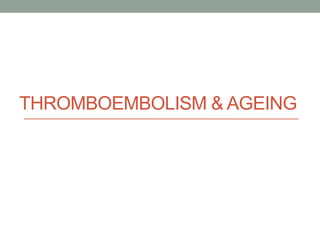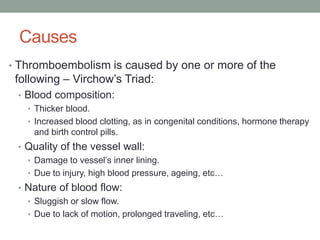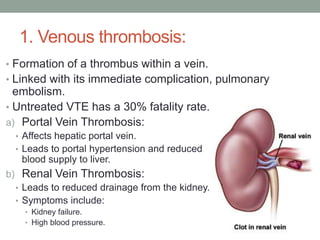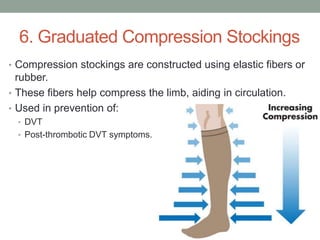Thromboembolism and Elderly
- 2. Ageing and the Cardiovascular System • Cardiovascular changes occur with ageing among individuals normally considered healthy. • Heart tends to get enlarged and the pumping action decreases. • Large elastic arteries exhibit increases in wall thickness, become dilated and stiffer. • Blood vessels loose elasticity, resulting in swelling of the feet, high blood pressure and heart failure. • Level of coagulation factors increase, which increases tendency of the blood to clot.
- 3. Ageing and the Cardiovascular System • These changes can increase the incidence of conditions in the elderly, such as: • Atherosclerosis • Hypertension • Stroke • Thromboembolism • Heart failure • Aging, per se, is a major risk factor for these diseases.
- 5. Thrombosis and Embolism • Thrombosis is the formation of a blood clot inside a blood vessel, obstructing the flow of blood. • Sequence of events is as follows: 1. Blood vessel is injured. 2. Body uses platelets and fibrin to form a clot - preventing blood loss. 3. If the clotting is severe and part of the clot breaks free, an embolus is formed. 4. An embolus can then lodge itself anywhere else in the body. 5. Thromboembolism is the combination of thrombosis and its main complication, embolism. • If proper conditions present themselves, blood clots will form in absence of blood vessel injury.
- 6. Thrombosis and Embolism • Upon diagnosis, there are often many emboli of different age, size and at different sites. • A thrombus occupying > 75% of surface area of the lumen of an artery reduces tissue blood flow enough to cause: • Hypoxia: Oxygen deficiency. • Accumulation of metabolic products (e.g. lactic acid). • > 90% obstruction can result in: • Anoxia: complete deprivation of oxygen. • Infarction: a mode of cell death.
- 7. Causes • Thromboembolism is caused by one or more of the following – Virchow’s Triad: • Blood composition: • Thicker blood. • Increased blood clotting, as in congenital conditions, hormone therapy and birth control pills. • Quality of the vessel wall: • Damage to vessel’s inner lining. • Due to injury, high blood pressure, ageing, etc… • Nature of blood flow: • Sluggish or slow flow. • Due to lack of motion, prolonged traveling, etc…
- 9. Types • Venous Thrombosis • Arterial Thrombosis
- 10. 1. Venous thrombosis: • Formation of a thrombus within a vein. • Linked with its immediate complication, pulmonary embolism. • Untreated VTE has a 30% fatality rate. a) Portal Vein Thrombosis: • Affects hepatic portal vein. • Leads to portal hypertension and reduced blood supply to liver. b) Renal Vein Thrombosis: • Leads to reduced drainage from the kidney. • Symptoms include: • Kidney failure. • High blood pressure.
- 11. 1. Venous Thrombosis c) Deep Vein Thrombosis (DVT): • Formation of a blood clot within a deep vein. • Most commonly affects leg veins – femoral vein. • Classical signs of DVT: swelling, pain and redness. • In the long term, it can lead to post-phlebitic syndrome - dermatitis, cellulites, varicose veins, skin pigmentation and chronic ulceration of lower leg.
- 13. 2. Arterial Thrombosis: • Formation of a thrombus within an artery. • Possible causes include atherothrombosis and atrial fibrillation. • Arterial embolism can result in an infarction of almost any body organ. a) Ischemic Stroke: • A thrombus in arteries of the brain. • Results in a rapid decline in brain function due to disturbance of blood flow. • Symptoms include: • Sudden weakness or numbness in one side of the body. • Sudden dimness or loss of vision. • Sudden slurred speech or loss of speech.
- 14. 2. Arterial Thrombosis b) Myocardial Infarction: • Caused by an infarct, often due to obstruction of coronary artery by a thrombus. • If diagnosed within 12 hours of the initial attack, thrombolytic therapy is initiated. • Symptoms include: • Sudden chest pain • Dyspnea • Palpitations and sweating
- 15. Diagnosis • Medical history. • Physical exam. • Diagnostic tests: • Ultrasound • D-dimer test • Venography • Blood tests. • Lung Ventilation Perfusion Scan – in case of pulmonary embolism.
- 16. Prophylaxis • Thromboprophylaxis (prevention of thrombosis) is increasingly emphasized. • Thrombosis and embolism can be partially prevented with anticoagulants in those deemed at risk. • Generally, a risk-benefit analysis is required, as all anticoagulants lead to a small increase in the risk of major bleeding. • Elderly are usually at higher risk of suffering from such bleeding or hemorrhage. • For example, in atrial fibrillation, the risk of stroke needs to outweigh the small but known risk of major bleeding associated with the use of warfarin.
- 17. Treatment • Treatment with heparin and thrombolytic agents is clearly effective in patients age 65 and older, despite increased susceptibility of hemorrhagic complications. • Careful evaluation of individual hemorrhagic risk, dosage modification, and careful laboratory monitoring may decrease the number of clinically significant bleedings without impairing therapeutic results.
- 18. Treatment • Main goals of treatment: • Stopping the clot from getting bigger. • Preventing embolism. • Reducing chance of having another blood clot. • Pharmacological treatment: • Anticoagulants • Thrombin inhibitors • Antiplatelet Drugs • Thrombolytics (fibrinoyltics) • Other treatment: • Vena cava filter • Graduated compression stockings
- 19. 1. Anticoagulants • Include: • Warfarin (Oral) • Heparin (IV) • Most common treatment, also known as blood thinners. • Decrease blood’s ability to clot, and stops existing clots from getting bigger. • Can’t break up already formed clots. • Since heparin acts quickly and warfarin takes 2 to 3 days to work, combination treatment is useful where heparin is started until warfarin starts to work, then heparin in stopped. • Treatment duration often lasts from 3 to 6 months. • Most common and threatening side effect is bleeding or hemorrhage.
- 20. 1. Anticoagulants • People treated with blood thinners usually have regular blood tests to measure their blood's ability to clot, including PT, PTT and INR tests. • Coumarins: • Vitamin K antagonists, such as Warfarin. • Helps prevent future blood clots and reduces risk of embolism. • Close monitoring of degree of anticoagulation (INR) is required to avoid hemorrhage. a) Heparin and derivatives: • Antithrombin III activator – blocks thrombin from clotting blood. • Low molecular weight heparin is preferred in elderly because of: • More predictable plasma levels. • Lower risk of bleeding. • Lower risk of heparin-induced thrombocytopenia.
- 21. 2.Thrombin Inhibitors • Interfere with the blood clotting process. • Directly inhibits the enzyme thrombin. • Used to treat blood clots in patients with contraindications to heparin.
- 22. 3. Antiplatelet Agents • Mainly used in arterial thrombosis. • Act by inhibiting the activity of platelets. • Members include: • Aspirin • Thienopyridines: Clopidogrel and Ticlodipine • Low-dose Aspirin therapy has a modest antithrombotic effect, preventing approximately 25% of cardiovascular events. • Modest effect is the result of other platelet activators, not inhibited by Aspirin. • Thienopyridines are marginally superior to Aspirin in preventing atherothrombosis in the cerebral and peripheral arteries, but not in the coronary arteries. • Adverse effects include: • Risk of bleeding • Gastrointestinal bleeding
- 23. 4. Thrombolytics • They work on quickly dissolving an existing blood clot. • Used to clear blocked arteries and avoid permanent damage to tissues. • Used only in life-threatening situations, due to risk of sudden bleeding. • Contraindications: • Absolute: • Active bleeding. • Uncontrolled high blood pressure. • Previous intracranial bleeding. • Relative: • Current anticoagulant use. • Pregnancy. • Active peptic ulcer. • Severe hypertension
- 24. 4. Thrombolytics • Types: • Recombinant tissue plasminogen activator (rt-PA) • Streptokinase • Urokinase • Anistreplase • Streptokinase: • Given as IV infusion. • May be preferable to rt-PA in elderly due to lower risk of stroke and cerebral hemorrhage. • Best outcome is achieved within the first 60 minutes, but may extend up to 6 hours after initiation of symptoms. • Except for streptokinase, thrombolytics are often given in combination with intravenous heparin.
- 25. 5. Vena Cava Filter • A surgical device implanted into inferior vena cava. • Prevents fatal pulmonary embolism. • Works to trap released emboli. • Used in case of: • Contraindication to anticoagulation therapy. • Failure of anticoagulation therapy. • Presence of large clots. • Patients at high risk of pulmonary embolism.
- 26. 6. Graduated Compression Stockings • Compression stockings are constructed using elastic fibers or rubber. • These fibers help compress the limb, aiding in circulation. • Used in prevention of: • DVT • Post-thrombotic DVT symptoms.
- 27. Precautions • Blood-thinning medications can sometimes cause internal or external bleeding, especially in the elderly. • Internal bleeding can occur in the digestive system or the brain. • Signs and symptoms of bleeding in the digestive tract: • Bright red vomit. • Bright red blood in stool, or black, tarry stools. • Pain in abdomen.
- 28. Precautions • Signs and symptoms of bleeding in the brain: • Severe pain in head. • Sudden changes in vision. • Sudden loss of movement in arms and legs. • Memory loss or confusion. • Seek treatment immediately if you suffer excess bleeding after injury. • Talk to your doctor before taking any drugs, including OTCs such as aspirin, which can contribute to blood thinning.
- 29. THANK YOU!





























